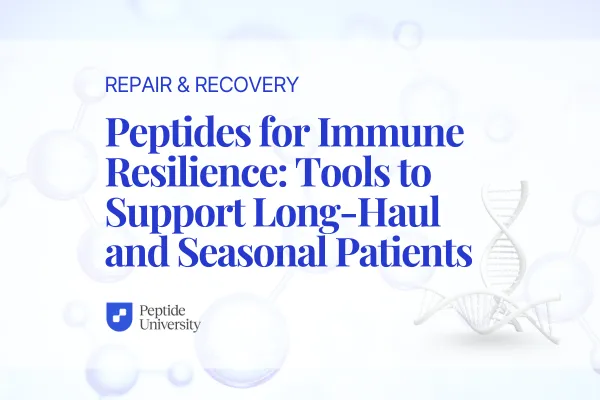
Repair & Recovery: How Peptides Transform Clinical Healing Timelines
Why Healing Timelines Matter More Than Ever
Every clinician has faced the same patient frustration:
“Why is this taking so long to heal?”
Whether it’s a torn ligament, a slow post-surgical recovery, or chronic tendon pain, the gap between patient expectations and biological healing timelines can erode trust, compliance, and outcomes.
This is where peptide therapy is changing the game. By leveraging molecules like BPC-157 and TB-500, practitioners are witnessing faster tissue repair, reduced inflammation and more predictable recovery timelines.
For integrative and regenerative medicine practices, peptides are becoming indispensable.
💡 Clinical Faculty Insight: Shortening recovery time isn’t just about healing tissue—it’s about restoring trust, reducing frustration, and helping patients return to their lives faster.
The Science Behind Repair & Recovery Peptides
BPC-157: The Body Protection Compound
BPC-157, derived from a gastric peptide, has been shown to:
Enhance angiogenesis, improving blood flow to injured tissues
Stimulate fibroblast and collagen repair activity (tendon, ligament, gut)
Protect the endothelial lining, supporting vascular integrity and reducing inflammation
Research Evidence: Animal and early human studies demonstrate accelerated healing in tendon-to-bone injuries, muscle tears, and gastric ulcers (Gwyer et al., 2022; Pevec et al., 2021).
TB-500 (Thymosin Beta-4 Fragment)
TB-500 is a synthetic peptide fragment of thymosin beta-4 that supports:

Cell migration and differentiation critical to tissue remodeling.
Reduction of pro-inflammatory cytokines in damaged tissue.
Enhanced angiogenesis and wound closure in soft tissue and cardiac models (Bock-Marquette et al., 2004).
When paired with BPC-157, TB-500 provides a synergistic effect: BPC-157 primes the repair environment, while TB-500 mobilizes stem cells and endothelial cells to accelerate the process.
📖 (References: Gwyer D, et al. Front Pharmacol. 2022; Pevec D, et al. J Orthop Surg Res. 2021; Bock-Marquette I, et al. Nature. 2004).
Routes of Administration: Oral vs. Subcutaneous
One of the most common practitioner questions is:
“What’s the best way to deliver repair peptides?”
Subcutaneous injections remain the gold standard for systemic effects and tissue-targeted repair. They offer higher bioavailability and more consistent outcomes.
Oral capsules of BPC-157 have gained traction for gut-related repair (ulcers, IBS, leaky gut) due to local GI stability and ease of use.
Clinical pearl: oral BPC-157 is best for gut and systemic inflammation, while subQ is preferred for musculoskeletal repair.
TB-500 is most often delivered subcutaneously or intramuscularly for musculoskeletal conditions, as oral forms are not clinically validated.
💡 Clinical Faculty Insight: Match the route of administration to the tissue you want to target. Gut issues may respond best to oral BPC-157, while tendon tears demand subQ support.
Practical Applications in Clinical Practice
When to Consider Repair Peptides:

Post-surgical recovery (orthopedic, abdominal, dental).
Athletic injuries (muscle, tendon, or ligament tears).
Chronic musculoskeletal pain resistant to conventional therapies.
Gut healing and systemic inflammation.
Adjunct to regenerative procedures (PRP, stem cell therapy).
Clinical Protocol Considerations:
BPC-157: 250–500 mcg daily (subQ) for 4–6 weeks. Oral forms may be dosed 500–1,000 mcg daily for gut-related protocols.
TB-500: 2–5 mg weekly (subQ) for 4–6 weeks, often front-loaded for the first 2 weeks, then tapered.
Stacking: Many clinicians layer BPC-157 daily with TB-500 twice weekly for synergistic recovery.
⚠️ Note: These are research-informed educational references only. Clinical use must follow local regulations, compounding guidance, and informed consent.
Access and Clinical Navigation
A major barrier for clinicians is not the science—but the sourcing and compliance landscape.
Research-grade peptides may be available for patient-directed protocols, but clinicians must clarify their limitations and provide proper disclaimers.
Compounded peptides (when legally available) remain the gold standard for safety, purity, and patient assurance.
Supplement-grade formulations (oral capsules of BPC-157) are accessible in some jurisdictions and can be integrated into gut protocols.
This is why education matters—knowing how to navigate access, quality assurance, and informed consent ensures both patient safety and practitioner confidence.
Transforming the Healing Conversation
Patients often arrive conditioned by the “6–12 week recovery” narrative. But when they experience accelerated timelines—walking sooner after surgery, returning to sport with less pain, or finding gut stability after years of struggle—it changes everything.
For the practitioner, peptides are not just molecules. They are relationship-builders. Faster healing means stronger patient trust, improved compliance, and more referrals.
Leading the Future of Recovery Medicine
Peptides like BPC-157 and TB-500 are transforming how we think about tissue repair and healing. By reducing inflammation, accelerating regeneration, and offering new access points (oral vs. subQ), they give clinicians a powerful edge.
The challenge isn’t whether these molecules work—the data and clinical results speak for themselves. The challenge is whether you, as a practitioner, are ready to integrate them.
📌 Explore more on this topic inside our masterclasses at MyPeptideUniversity.com.


